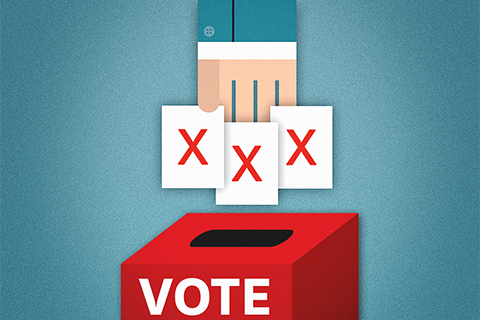The notion that every adult citizen should have an equal say in electing a government is an essential principle of democratic countries around the world, including Canada. The concept is simple: each citizen gets precisely one vote. But in the messy world of real-life politics, it turns out that some votes count for more than others – a lot more. In Canada, for example, the Member of Parliament for Oak Ridges-Markham represents more than six times as many people as the MP for Charlottetown. In other words, the people of Markham, Ontario, would have to be split into six groups – each electing their own MP – to be as well represented in Ottawa as the people of Charlottetown.
This clearly isn’t fair. And census data shows that, because of ongoing immigration and internal migration patterns, it’s most unfair to visible minorities, who make up a significant chunk of the population in the most under-represented ridings in the country (see chart, below). Nationally, 16 per cent of Canadians identify as visible minorities.
What’s the best way to fix this situation? And should perfect equality be the goal?
Matthew Mendelsohn, the director of U of T’s Mowat Centre at the School of Public Policy and Governance, notes that there are two kinds of imbalance in the Canadian electoral system: between provinces and within provinces. Imbalances between provinces exist partly for historical reasons (under the Constitution, for example, P.E.I. is guaranteed four seats even though it warrants only one by its current population), and partly due to population changes. Over the past three decades, Ontario, Alberta and British Columbia have grown much faster than other jurisdictions. Under new federal legislation, these three provinces have been awarded a total of 30 additional seats for the next election, which, although an improvement, is not quite enough to bring their per-capita representation in line with the other provinces. Urban and suburban regions within all provinces have also grown, so ridings in these regions, in theory, should be subdivided, while those in rural areas, which have seen population declines, should be merged.
The job of redrawing electoral districts falls once every decade to provincial “boundary commissions,” which, earlier this year, released a series of maps showing proposed new ridings. (In the fall, the public had an opportunity to comment on the proposals, which may subsequently be revised before they receive final approval in Ottawa.) While the maps indicate some progress, significant pockets of inequality persist, says Mendelsohn – although he adds that perfect voter equality is not necessarily the goal. “Canadians traditionally have been comfortable with the idea that the North and remote communities should receive greater representation,” he says, partly because a remote community’s “voice” can get lost relative to more powerful interests in urban areas. Also, provinces and regions that are overrepresented have traditionally refused to give up a seat in Ottawa.
Comparing provinces, Mendelsohn says the Ontario boundary commission “didn’t come close” to what the Alberta and B.C. commissions achieved with respect to voter equality. In the two westernmost provinces, the population of a large majority of the proposed new ridings falls within five per cent of the national average. In Ontario, almost half of the ridings exceed this differential. In Mendelsohn’s opinion, Ontario’s boundary commission erred by trying to keep federal electoral boundaries aligned with municipal ones. “Moving forward,” he says, “they need to do more to accept voter equality as the driving principle in rebalancing.”
Mendelsohn notes that immigrant communities have not traditionally advocated for greater representation in Ottawa, but he senses that this may be beginning to change. “People are more aware now that having two MPs for their community instead of four is a problem.”
| Riding Population | Population | % Visible Minority | Vote Weight |
| Oak Ridges-Markham | 228,997 | 42 | 0.47 |
| Brampton West | 204,146 | 54 | 0.53 |
| Halton | 203,437 | 19 | 0.53 |
| Canadian average | 108,691 | 16 | 1.00 |
| Charlottetown | 34,562 | 3 | 3.14 |







No Responses to “ Voter Inequality ”
Scott Anderson implies that a fair distribution of voters within electoral districts would make everyone equally well represented in Ottawa.
Unfortunately, this is not so. It would only allow voters to equally participate in not having their votes count. Our First Past the Post (FPP) electoral system guarantees that each voter is not represented in Ottawa.
Currently, there is only one vote in each district that counts toward representation - the one placing the winning party ahead of the closest rival. This is the basis of FPP. All other votes may be counted, but they surely do not count towards representation.
The most outrageous example of this was New Brunswick in 1987, when the Liberal Party won 100 per cent of the seats with only 60 per cent of the popular vote, leaving 40 per cent of voters unrepresented. However, this distortion of democracy occurs in every election.
The solution, proportional representation, is well known and used in most parliamentary democracies in the world. It is a simple system where the percentage of the popular vote for each political party determines its representation in parliament, thereby ensuring the makeup of parliament reflects the popular vote. With minor agreed-upon constraints, 40 per cent of the popular vote gets 40 per cent of the seats. Not only are votes counted, they truly count towards representation.
While Mr. Anderson's concern might seem important, correcting it would do little to ensure voters are equally represented. FPP robs us all of democracy, not just visible minorities.
Michael Blythe
Scotland, Ontario